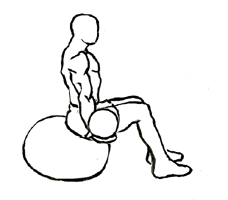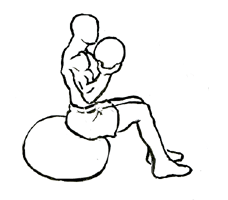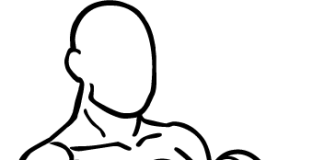Last Updated on September 26, 2014
The Medicine Ball Biceps Curl on Stability Ball is an innovative exercise that combines modern fitness tools with classic strength-training techniques. This exercise not only targets the biceps but also engages your core and stabilizing muscles, making it an excellent choice for a balanced, functional workout. Using a stability ball challenges balance and coordination, while the medicine ball provides resistance for your biceps, helping to build strength in both areas simultaneously.
In this guide, we’ll explore the benefits of this exercise, proper form, common mistakes, variations, and how to incorporate it into your workout routine. By mastering this move, you’ll be able to strengthen your upper body and core, improve balance, and add an exciting twist to your usual biceps workout.
Why the Medicine Ball Biceps Curl on Stability Ball is Effective
Combining the medicine ball and stability ball in one exercise delivers a range of benefits:
- Engages Core Muscles: Sitting on a stability ball forces you to engage your core to maintain balance. This turns a standard biceps curl into a functional movement that strengthens your core muscles.
- Improves Balance and Coordination: The instability of the ball challenges your balance, improving your coordination and proprioception (awareness of body position).
- Targets Biceps with Added Resistance: The medicine ball serves as a resistance tool, focusing on the biceps. The rounded shape requires you to grip it differently than a dumbbell, activating additional stabilizer muscles in your hands and forearms.
- Full-Body Integration: Engaging your lower body, core, and upper body simultaneously adds an extra layer of intensity, making this exercise great for anyone looking to improve functional strength and stability.
Muscles Targeted in the Medicine Ball Biceps Curl on Stability Ball
This exercise primarily targets the following muscles:
- Biceps: The main focus, helping to build arm strength and definition.
- Core Muscles: The abs, obliques, and lower back are engaged to keep you steady on the stability ball.
- Forearms and Hand Muscles: Holding the medicine ball with a wide grip activates the forearm muscles and finger flexors, enhancing grip strength.
- Shoulders and Upper Back: Sitting up straight on the ball requires upper back and shoulder engagement to maintain posture.
Step-by-Step Guide to Performing the Medicine Ball Biceps Curl on Stability Ball
Step 1: Get Into Position on the Stability Ball
- Sit on the Ball: Sit on the center of the stability ball with your feet firmly planted on the floor, about hip-width apart, for a stable base.
- Align Your Posture: Sit up straight with your shoulders pulled back and down, chest open, and head aligned over your spine.
- Engage Your Core: Pull your belly button in toward your spine to engage your core muscles, keeping your torso upright and balanced.
Step 2: Grip the Medicine Ball
- Hold the Medicine Ball with a Wide Grip: Spread your fingers wide across the medicine ball, using a firm but controlled grip. This grip style enhances forearm activation and balance.
- Start with One Arm: Hold the medicine ball in one hand, letting your arm hang down by your side with a slight bend in the elbow.
Step 3: Perform the Biceps Curl
- Curl the Medicine Ball Up: In a controlled motion, curl the medicine ball up toward your shoulder by bending your elbow. Keep your upper arm stationary and close to your body to isolate the biceps.
- Focus on the Biceps: As you curl, concentrate on squeezing the biceps to lift the weight rather than using momentum.
Step 4: Pause and Return to Starting Position
- Hold at the Top: Once the medicine ball reaches shoulder height, pause briefly to intensify the muscle contraction in your biceps.
- Lower Slowly: Lower the ball back to the starting position in a controlled manner, keeping tension on the biceps throughout the movement.
- Switch Arms: Once you’ve completed a set on one arm, switch the medicine ball to the other hand and repeat the movement.
Tips for Perfecting Your Form
Maintaining proper form is crucial for maximizing the effectiveness of this exercise and preventing injury. Here are some tips to keep in mind:
- Keep Your Core Engaged: Your core should remain tight throughout the exercise to maintain balance and stability on the ball.
- Avoid Swinging: Perform the movement slowly and avoid using momentum to lift the ball. This isolates the biceps and prevents unnecessary strain on the shoulders or lower back.
- Maintain Posture: Keep your back straight and shoulders back. Slouching can lead to poor form and may reduce the effectiveness of the exercise.
- Use a Moderate Weight: Start with a lighter medicine ball (2–5 kg) to master the form, especially if you’re new to stability ball exercises. As you progress, you can increase the weight.
Common Mistakes and How to Avoid Them
To get the most out of the Medicine Ball Biceps Curl on Stability Ball, avoid these common mistakes:
- Arching the Back: Leaning too far forward or arching the lower back reduces core engagement and can lead to injury. Keep your back straight and core activated.
- Using Momentum: Swinging the ball up instead of using a controlled curl shifts focus away from the biceps. Slow down the movement to maintain control.
- Poor Grip: Failing to spread your fingers wide on the medicine ball reduces stability and grip strength. A wide grip helps keep the ball balanced.
- Neglecting the Core: Forgetting to engage your core compromises stability. Remember to tighten your abs and maintain an upright posture throughout.
Variations of the Medicine Ball Biceps Curl on Stability Ball
Adding variety to this exercise can challenge your muscles in new ways and prevent workout monotony. Here are some variations to try:
1. Two-Arm Biceps Curl
Hold the medicine ball with both hands, keeping your elbows close to your sides. Curl the ball up toward your chest with both arms simultaneously. This variation increases the load on your biceps and engages both sides of the body equally.
2. Alternating Arm Curl
Instead of switching arms after each set, alternate arms with each repetition. This variation challenges your coordination and requires even greater core stability as you balance on the stability ball.
3. Incline Medicine Ball Biceps Curl
Adjust your position on the stability ball by leaning back slightly so that your torso is at an angle. Curling the medicine ball from this inclined position shifts the emphasis to the long head of the biceps, adding variety and increasing the difficulty.
4. Overhead Medicine Ball Extension
To further engage the core and shoulders, start by holding the medicine ball above your head with both hands. Lower the ball behind your head in a triceps extension motion, then bring it back up. This variation targets both the triceps and the biceps, adding a more comprehensive upper-body workout.
5. Single-Leg Medicine Ball Curl
Lift one foot off the floor while performing the curl. This variation increases the challenge to your core and leg stability, requiring greater focus on balance.
Sample Upper Body and Core Workout Including the Medicine Ball Biceps Curl
Incorporate the Medicine Ball Biceps Curl on Stability Ball into a balanced workout that targets the arms, shoulders, chest, and core. Here’s a sample routine:
- Warm-Up: 5-10 minutes of light cardio and dynamic stretching for the upper body.
- Push-Ups on Stability Ball: 3 sets of 10-12 reps to engage the chest, triceps, and core.
- Medicine Ball Biceps Curl on Stability Ball: 3 sets of 10 reps per arm, focusing on control and balance.
- Dumbbell Shoulder Press: 3 sets of 8-10 reps for shoulder strength.
- Plank on Stability Ball: Hold for 30-45 seconds to engage the core.
- Alternating Dumbbell Rows: 3 sets of 10 reps per arm for upper back and biceps.
- Russian Twists with Medicine Ball: 3 sets of 15 reps per side to strengthen the core and obliques.
- Cool Down: Light stretching for the arms, shoulders, and core to aid recovery.
Safety Tips for the Medicine Ball Biceps Curl on Stability Ball
Since this exercise involves balance and a free-moving weight, safety is essential. Here are some tips:
- Start with a Stable Position: Before beginning the curl, ensure you feel balanced on the stability ball. Practice sitting on the ball and engaging your core if you’re new to stability ball exercises.
- Choose a Lighter Medicine Ball: It’s better to use a lighter weight to maintain control, especially if you’re unfamiliar with using a stability ball.
- Keep the Movement Controlled: Avoid rapid movements or jerking. Maintaining control reduces the risk of slipping off the stability ball or straining the muscles.
- Use a Spotter if Necessary: If you’re working with a heavier medicine ball or just starting out, a spotter can help you maintain balance and offer guidance on form.
Progressive Overload Techniques
To continuously challenge yourself and see progress with the Medicine Ball Biceps Curl on Stability Ball, apply progressive overload:
- Increase the Weight of the Medicine Ball: Start with a lighter medicine ball (2-5 kg) and gradually increase as you build strength.
- Add Repetitions or Sets: Once you’re comfortable with a certain weight, try increasing the number of repetitions per set or adding an extra set to enhance endurance and stimulate muscle growth.
- Slow Down the Tempo: To increase time under tension, slow down the movement, particularly the lowering phase. This requires more control and further activates the biceps, core, and stabilizer muscles.
- Increase Instability: As you become more skilled, challenge your balance further by lifting one leg off the ground during the curls, or perform the curls on an incline using the stability ball. This heightens the core demand and engages the stabilizer muscles more intensively.
Integrating the Exercise into Different Workouts
The Medicine Ball Biceps Curl on Stability Ball is highly versatile and can be integrated into various types of workouts:
- Upper Body Day: Include it as an isolation movement after compound exercises like push-ups or shoulder presses to focus on biceps and stability.
- Full-Body Functional Workout: Pair it with exercises like lunges, squats, or planks to create a functional circuit that improves balance and core strength.
- Core-Focused Day: Combine with other core exercises, such as Russian twists or plank variations, to enhance core stability alongside biceps strength.
Tracking Your Progress
To see improvements and stay motivated, track your progress by noting:
- Repetitions and Sets: Record the number of reps and sets completed each session. Progressively increasing these over time indicates strength and endurance improvements.
- Medicine Ball Weight: Keep track of the weight you’re lifting. Gradual increases reflect biceps and grip strength growth.
- Balance and Control: Jot down any changes in balance or form improvements. As you become more stable on the ball, you’ll notice greater ease in maintaining posture and balance throughout the movement.
- Core Stability: Note how your core feels during the exercise. Improved core engagement and stability often translate to better performance in other exercises as well.
Frequently Asked Questions (FAQs)
1. Can beginners perform the Medicine Ball Biceps Curl on Stability Ball?
- Yes, but beginners should start with a lighter medicine ball and focus on mastering balance and posture on the stability ball before progressing to heavier weights.
2. Is this exercise as effective as traditional biceps curls?
- While traditional biceps curls with dumbbells may allow for heavier loads, the Medicine Ball Biceps Curl on Stability Ball adds a functional element by engaging core muscles and improving balance, making it a well-rounded alternative.
3. How often should I perform this exercise?
- This exercise can be included in your routine one to two times a week, depending on your overall workout split. Since it engages core and stabilizer muscles, it’s ideal to include it in workouts focused on upper-body or functional strength.
4. What should I do if I feel unstable on the ball?
- Start by practicing sitting on the stability ball without weights to develop balance and core engagement. As you build stability, add a lighter medicine ball, then gradually increase the weight as your balance improves.
5. Can I perform this exercise with a dumbbell instead of a medicine ball?
- Yes, but using a medicine ball adds a unique grip challenge and engages stabilizer muscles differently. A dumbbell can be substituted if a medicine ball isn’t available, though you’ll lose some of the functional benefits.
Final Thoughts
The Medicine Ball Biceps Curl on Stability Ball is an effective and dynamic exercise that not only strengthens your biceps but also engages your core and stabilizer muscles, enhancing overall balance, coordination, and functional strength. This unique exercise is suitable for lifters of all levels, adding variety to traditional bicep training and challenging your body in new ways.
By focusing on proper form, applying progressive overload, and integrating this exercise into different types of workouts, you’ll enjoy the combined benefits of improved biceps strength, enhanced core stability, and better overall coordination. Make the Medicine Ball Biceps Curl on Stability Ball a regular part of your routine to elevate your fitness level and bring a new dimension to your arm workouts. With consistency and commitment, you’ll see noticeable improvements in your strength, balance, and functional fitness.








